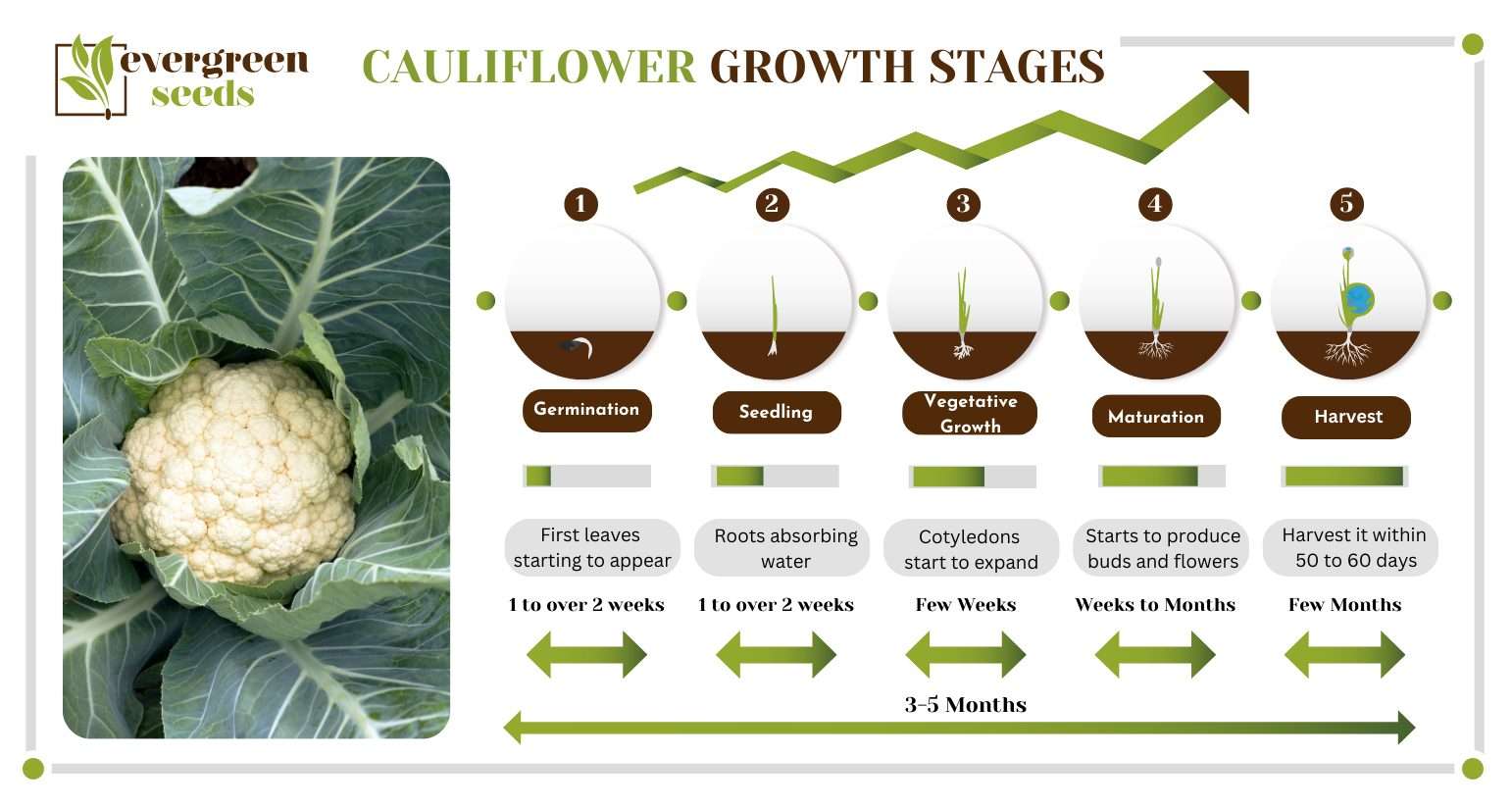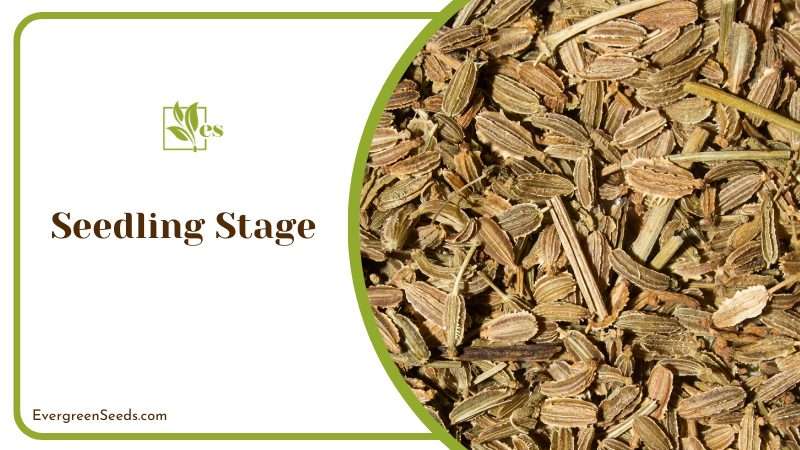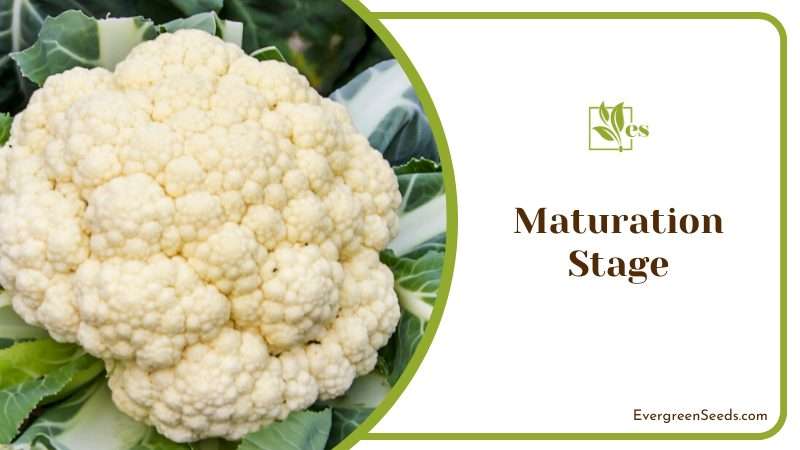- When to Plant Corn in San Diego: Optimal Seasons and Tips - July 19, 2024
- When to Plant Hydrangeas in Illinois: Best Timing for Optimal Growth - July 19, 2024
- Why Are My Radishes Growing Above Ground: Uncovering the Causes - July 19, 2024

Cauliflower growing stages involve four specific phases, each with requirements and technicalities that a gardener must be familiar with. Like any other living being, a cauliflower plant goes through many stages of growth.
It’s important to learn them if you’re planning to grow them in your backyard. We have researched in detail the four growth stages of the cauliflower plant, along with what it needs in each stage to grow well, so to find out more, keep on reading!
JUMP TO TOPIC
The Four Growing Stages Of Cauliflower
There are four major stages of cauliflower growth:
- Germination
- Seedling
- Vegetative
- Maturation (also known as the flowering stage)
Cauliflowers are a type of cabbage that belongs to the family called Brassicaceae. This family is known for its somewhat developed flower structures and fleshy stalks.
Cauliflower is an edible plant which reproduces by seed. The fleshy head of the plant is popular in many cuisines throughout the world.
You can grow a healthy cauliflower by learning all about these stages. So what’s the wait? Let’s get into the cauliflower growth stages!
– Germination Stage
The process that includes a seed sprouting and the first leaves starting to appear is called germination. Cauliflowers are annual plants that grow from seeds. Cauliflowers are best planted during spring or fall. If so, you’ll get the harvest in three to five months.
You can either start the cauliflower life cycle in seed trays or in the garden. Although, we would recommend you start your cauliflower plant indoors. That way, you can keep the environment under control, especially if you live in an area with unpredictable weather conditions.
A young cauliflower is more sensitive. Moreover, it needs further care and affection. You can control the indoor temperature and lighting according to your plant’s needs.
And when the plant has matured enough, you can transplant it to the outside garden.
After sowing the seed of the cauliflower plant, you must cover them with a thin layer of soil and sprinkle some water on top to keep it moist. Within eight to ten days, your seeds will begin to germinate.
At this point, the plant will need sunlight, water, nutrients, and proper temperature. Germination is the first growth stage of the plant, and if it goes wrong, the plant won’t grow properly. After germination, the cauliflower seeds begin to grow with full force.
– Seedling Stage
After germination, a sporophyte grows out of a plant’s embryo from a seed. The basic function of a sporophyte is to manufacture spores in plants. A cauliflower plant’s seedling has three parts:
- A radicle: this is the first organ to appear after germination. It grows into the garden’s type of soil and anchors the seedling. Many people call it the primary root or the embryonic root.
- The cotyledons: these are the first leaves to grow on a plant. They’re not actual leaves which is why they’re referred to as seed leaves. They are a part of the plant’s embryo.
- The hypocotyl: this is the part of a plant’s embryo that can be found between the radicle and the cotyledons. It grows up to become a part of the plant’s stem.

The radicle is the first structure of the plant that absorbs the nutrients, and the hypocotyl is the first structure to carry those nutrients. In a similar way, the cotyledons are the first structure of the plant that absorbs sunlight (any kind of sunlight, direct and indirect).
These structures later grow up to form roots, stems, and leaves and fulfill their designated functions. Roots become responsible for absorbing water and nutrients from the soil and sending it to the stem. The stem takes the substances up to the leaves, flowers, and fruits to fulfill their needs.
– Vegetative Stage
The vegetative stage in a cauliflower plant begins when the radicles, hypocotyl, and cotyledons start to expand and form into distinct parts of the plant. The leaves and roots will start to form complex structures like root hairs and stomata.
Together, these secondary parts of the young cauliflower plant supply the plant with food and water and synthesize the necessary substances.
For example, the stomata are responsible for the exchange of water, the xylem and phloem are in charge of circulating food, and water throughout the plant, and the root hairs increase the intake of water.
At this vegetative stage of cauliflower, it starts to grow in height and width. The heads are the edible part of the plant, and during this stage, the formation of the heads commences. It is necessary to meet the plant’s light, nutrient, and water needs during this period. Purified tap water can be used without any issues.
Many gardeners make the mistake of over-feeding their plants with nitrogen-rich fertilizer at this stage. This is a mistake as excess nitrogen will prevent the plant from growing healthy heads.
Nitrogen will lead to the growth of excess foliage with dramatic leaves, but the roots will start to get stunted, and the energy of the plant will divert from the heads to the foliage.
Stunted roots mean that the plant can no longer support itself, and that can’t be good, right?
– Maturation Stage
The cauliflower maturation state is also known as the cauliflower plant flowering state. This is because, during this stage, the cauliflower starts to produce buds and flowers.
The production of flowers and buds is a sign that the plant is planning to reproduce. These flowers will start making pollen that’ll be waiting to be carried to a new spot to start a new cauliflower plant.

The arrival of the maturation stage also implies that the plant is now mature enough and has developed all the vital organs necessary for reproduction.
This means that it is all grown up and is now ready for harvest. This is the final stage of the growth of cauliflower. After the flower starts to appear, you’ll know that now’s the time to harvest.
When the head of the cauliflower, also known as the curd, reaches about 6 to 12 inches in diameter, it’s time to cut it off.
A mature head is white and has a firm structure. To take it off, you’ll have to detach it from the main stem but leave a few outer leaves on it to help protect the head and prolong its shelf life.
That’s it! You can now enjoy fresh cauliflowers right from your backyard.












